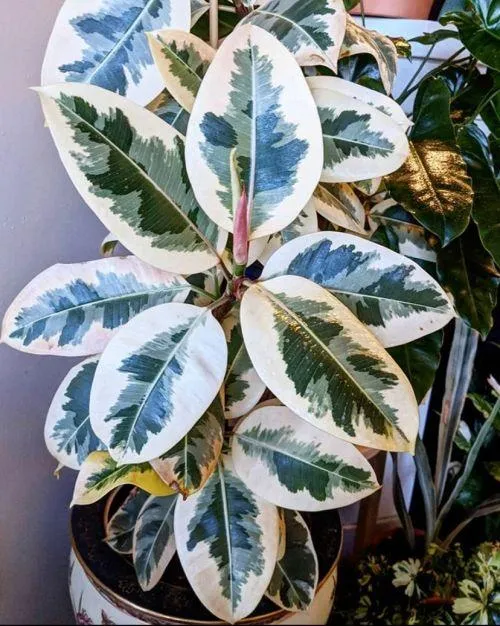Your Guide to Choosing the Perfect Variegated Foliage Houseplant
If you’re intrigued by plants with colorful, patterned leaves, a variegated houseplant may be just what you’re looking for. With their eye-catching variegation, these plants can add visual interest and pizzazz to any indoor space. However, with so many options to choose from, deciding on the right variegated plant for your needs can feel overwhelming.
In this article, I’ll break down the different types of variegation, care requirements, and popular variegated plant varieties to help you select the perfect match. By the end, you’ll be equipped to pick a stunner for your home that will thrive under your care.
Understanding Variegation
Variegation refers to the uneven pigmentation in plant leaves, usually presenting as streaks or splotches of white, yellow, pink or cream contrasting with the normal green coloration. This pigment variation is caused by a genetic mutation preventing certain plant cells from producing chlorophyll, the substance that makes leaves green.
There are two main types of variegation:
- Stable variegation: The color pattern remains consistent as the plant grows and is preserved through cuttings or new growth. Stably variegated plants are generally hardier.
- Unstable variegation: The leaves may revert partially or fully green over time, especially if the plant is stressed. Unstable variegation requires more care.
Some key factors determining ease of care for variegated plants include light/temperature needs, water requirements, and susceptibility to leaf drop.
Low-Maintenance Variegated Picks
If you’re new to plant parenthood, here are some reliably beautiful yet low-fuss variagated options:

Chinese Evergreens (Aglaonema)
With their creamy margins and dark centers, Chinese evergreens are classic beauties. They tolerate low-light and withstand brief periods of dry soil between waterings. Perhaps the hardiest variegated plant, mine have thrived with minimal care for years.
Peperomia (Peperomia spp.)
These tropical beauties come in an incredible array of leaf shapes, sizes and patterns. Brightly variegated “Ruby Cascade” peperomia is especially dramatic yet resilient. Just water weekly and give it bright, indirect light.
Nerve Plants (Fittonia)
When fittonia’s red veins blaze against its green and white leaves, it’s easy to see how it earned its name. Keep the soil moist and place in a spot with indirect sunlight or artificial light for constant color.
Intermediate-Care Varieties
As your plant parenting skills progress, consider these visually striking yet slightly temperamental choices:
Prayer Plants (Maranta)
With their elegant, pleated leaves marked by ferns of red, pink or white, prayer plants are true showstoppers. Mine loves bright, humidified conditions but can adapt with consistent watering. Leaf droppage occurs without perfect care.
Polka Dot Plants (Hypoestes)
Charming white-dotted leaves make these look like little works of art. Provide morning sun and keep the soil consistently moist to prevent scorched edges. They wilt dramatically but perk up after watering.

Monstera (Monstera deliciosa)
Famous for its gigantic fenestrated leaves, variegated monsteras have a cult following. Their lack of chlorophyll means extra sunlight and consistent moisture are crucial to prevent full reversion. Worth the effort for such a statement plant!
Advanced Care Varieties
Once you’ve gained substantial plant parenting experience, high-maintenance yet ultra-spectacular variegated plants may satisfy your green thumb, such as:
Variegated Philodendrons
Gorgeous heart-shaped leaves splotched in cream, yellow and pink make philodendrons look like delicate works of art. However, their variegation is unstable and they wilt at even slight underwatering.
Variegated Pothos
The classic heartleaf philodendron’s trailing variegated forms require very bright light to prevent full reversion. Their lush vines can grow over 10 feet long if conditions are optimal!
Final Considerations
Before making your selection, evaluate your home’s conditions. South-facing windows provide the brightest natural light variegated plants generally require. Be realistic about your schedule and watering consistency too. With the right match for your environment and skills, enjoying gorgeous variegated foliage can be extremely rewarding.
I hope this overview has helped clarify your variegated plant options and caring needs. Feel free to experiment – it’s all part of the learning process. With some trial and error, you’ll soon be an expert at choosing showstoppers that thrive under your care. Happy planting!

Important Facts About Variegated Leaf Plants
| Common Types | Leaf Variegation Pattern | Care Requirements |
|---|---|---|
| Pothos | Golden yellow splotches or borders | Low light, tolerate neglect, let soil dry between waterings |
| Philodendron | Cream or white borders or streaks | Moderate light, keep soil moist but not soggy, prune off wilted leaves |
| Peperomia | Marbled white patterns | Bright indirect light, allow top inch of soil to dry between waterings, propagate by stem or leaf cuttings |
| Chinese Evergreens | White edges or cream centers | Bright indirect light, keep soil evenly moist, pinch back stems for bushier growth |
| Dieffenbachia | White splashes, streaks or blotches | Medium to low light, keep soil slightly moist, toxins in sap can irritate skin and mouths of pets |
FAQ
-
What colors can variegated leaf plants have?
Variegated leaf plants can have all sorts of colors! Usually they have green leaves with white, pink, yellow or even red stripes or spots. The color combinations are basically endless.
-
Do these plants need more or less sunlight than regular plants?
Despite having colorful leaves, variegated plants usually need a bit more sunlight than plants with only green leaves. The white or light colored parts of the leaves are not able to photosynthesize as well, so these plants depend more on the green areas. At the same time, too much sunlight can scorch the delicate variegated leaves.
-
Will the variegation stay consistent or could it change over time?
The variegation pattern may kind of stay the same for a while, but it can potentially change as the plant grows. Stronger sunlight could cause more white breakouts to appear. Alternatively, the plant may slowly lose variegation in lower light. Sometimes cells named “chloroplasts” that generate the green pigment may spread or recede, affecting the look.
-
Why are some variegated plants more valuable?
Rare or unusual variegation patterns make certain varieties pretty amazing collector’s items. However, variegation may also disappear in a plant’s progeny over generations, so the original is extra special. Variegated mutants found in nature often command stunning prices, as admirers want preserved clones of that one-of-a-kind discovery. Their supply can never be increased, making them more treasured.
-
Can variegated plants lose their colorful leaves permanently?
It’s possible for a variegated plant to essentially “revert” over time and lose its variegation completely. Perhaps this could be due to genetic or environmental factors. Sometimes cells may mutate and the green pigment may take over every leaf. If a cutting is then taken from a reverted section, it may keep the green pattern when grown on. So in that sense, the original variegation could be gone for good from that individual plant.
-
Should variegated plants be treated any differently from regular ones?
While variegated plants have the same basic needs for water, light and nutrients as their green peers, there are a couple things to watch out for. The lighter parts of their leaves tend to burn more readily in strong sun, so they may need monitoring. And since the colors hamper photosynthesis to some degree, fertilizing slightly more often provides a little extra boost to their growth and vigor. But otherwise, you can grow these awesome plants similar to regular ones!

On the other hand, does this help explain variegated plants? Please let me know if you have any other questions! As the old saying goes, “Variety is the spice of life” – and variegated plants definitely add diversity and wonder to any garden or indoor space. Their unusual patterns are still kind of a mystery. Some experts suggest the markings may offer benefits like reflecting more light or repelling insects. But the causes are sometimes kind of puzzling even to botanists after all these years. In the end, we just appreciate their amazing good looks!
